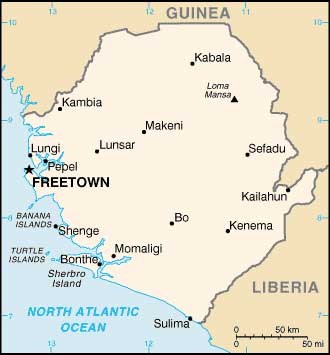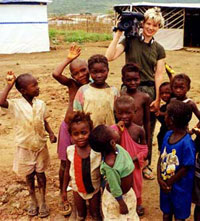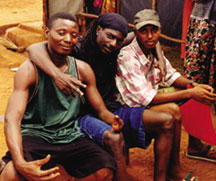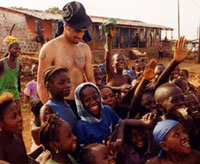 Introduction:
Introduction:
"Two rebel soldiers grabbed me and threw me to the ground. I got up and ran to my mother but the soldiers held her. They dragged me away again and I could see them raping my older sister as she screamed. Then they forced me to join their army and I never saw my family again."
Seemingly endless tears of heartbreak stream down the grief-stricken face of 17-year-old Rami, a refugee now living in Toronto, as he speaks. It is impossible not to weep along with the boy as he tells his horrifying story of being abducted into the army in war-ravaged Sierra Leone in West Africa.
Barely nine when his childhood ended, Rami's tragic life should be a stark reminder to the world that militarism and war breeds a culture of violence and oppression. There are no winners, only losers in this game called war. It fuels only despair amongst its victims especially the most vulnerable and marginalized - its innocent children.
According to Partnership Africa (PAC) after more than 10 years of war in Sierra Leone, the country has been battered and impoverished with upwards of 50,000 killed, half the population of 4.5 million displaced and more than two thirds of its already severely limited infrastructure destroyed.
The Canadian International Development Agency (CIDA) reports that 10,000 children have been separated from their families, and almost 3,000 children between the ages of 7 and 14 have been forced to serve as soldiers, child labourers, or sex slaves creating a legacy that is bound to doom future generations.
But no child ever started a war. Yet every time an armed conflict erupts throughout the world, children suffer the worst forms of atrocities. They are forced to live in fear and to give up their education. Adequate nourishment and clean water become scarce. They lose their limbs amputated by rebel forces or hacked off by exploding land mines. Child labour becomes commonplace, proper health care almost non-existent. Girls are robbed of their virginity, often in soul-destroying gang rapes. Little ones lose their lives; many lose family members. All lose their innocence.
The civil war in Sierra Leone has caused severe emotional wounds for so many of its citizens. Many of its children are growing up suffering from post-traumatic stress disorder, a debilitating psychological illness impairing their developmental process. For those under three years of age, the severe trauma can also permanently alter brain chemistry. And the life expectancy is one of the lowest in the world - a mere 34.
Throughout the war in West Africa, which has been fuelled by a corrupt diamond industry, there has been widespread and systematic sexual violence against women and girls including individual and gang rape, and violations with objects such as firewood or umbrellas. In thousands of cases, sexual violence has been followed by the abduction and obligatory bondage to male combatants in slavery-like conditions often accompanied by forced labour. Sexual crimes are frequently characterized by extraordinary brutality and preceded or followed by violent acts against other family members. The rebel factions use rape as a weapon to terrorize, humiliate, punish and ultimately control the civilian population into submission.
The violence has affected thousands of girls and women of all ages. While members of the Revolutionary United Front (RUF) and Armed Forces Revolutionary Council (the renegade members of the Sierra Leonean Army) have been the most common perpetrators, members of the civil defense forces - the biggest and most powerful of which are the Kamajors - and the loyal Sierra Leonean Army have also been implicated.
Following the l999 Lome Peace Accord, there was a marked decrease in most human rights violations - except sexual violence, which continued unabated. From the signing in July 1999 to the May 2000 collapse of the accord, Human Rights Watch, an independent, non-governmental organization based in New York City, documented some 100 cases of rape by rebel forces. Carroll Bogert, Communications Director of Human Rights Watch, says they have received consistent reports of rape since the collapse of the peace agreement.
"There are no official statistics on the numbers of girls and women who have suffered sexual violence during the war," Bogert said, explaining this is due both to under-reporting because of cultural factors, fear of retaliation, and lack of faith in the criminal justice system, and to scarce resources devoted to the problem on the part of the relevant government ministries. Human Rights Watch, whose efforts to eradicate landmines won them a Nobel Peace Prize in 1997, reports that while it is common for women to know the perpetrators, very few have dared to bring charges for fear of reprisals against them and their families. However, those girls who have been either released or managed to escape rebel captivity indicate the overwhelming majority are sexually abused, many becoming pregnant.
Rami, an intelligent and handsome young man, arrived in Canada two years ago as a refugee after fleeing his poverty-stricken birthplace of Zimmi in Sierra Leone near the border of Liberia. He continues to struggle to rebuild his life in a foreign land after losing virtually all of his blood relatives. But the recurring night terrors each time he attempts to sleep and his inability to trust virtually anyone, fuel a constant state of anxiety and fear.
"I spent nearly three years in captivity before I escaped," Rami said between gut-wrenching sobs. "We were often forced to kill other children as a way of training us. We are always haunted by these actions, even after counselling." The girls who were in rebel captivity feel used, he added, which has often destroyed their self-esteem. In addition to being used as sex slaves, the girls were required to do all the domestic chores. "We were all beaten every day. Many girls who have had babies remain in captivity," Rami, who admitted using every drug imaginable to shield himself from his haunting memories, said sadly. "I do not feel safe, or normal without my rifle by my side."
The Consequences to the Innocents:
As a result of war and armed conflicts between 1985 and 1995, more than 2 million children were slaughtered, 6 million were seriously injured or permanently disabled, and 12 million were left homeless, according to a 1997 UNICEF report on the State of the World's Children. The trauma experienced by children of war can include:
(1) Physical injury or death of themselves or a loved one,
(2) Rape, or other forms of torture, and
(3) Horrific experiences as a child soldier.
1. Physical Injury
UNICEF estimates that between 80 and 90 percent of people who die or are injured in conflicts are civilians, and most of them women and their children. Many refugees arriving in Canada, including Rami, have had limbs amputated either by the rebel forces or ripped off during a landmine explosion. War often destroys infrastructures impacting health and social services, the quality of water sanitation and access to energy sources. Communicable diseases such as HIV/AIDS, tuberculosis and smallpox are left untreated and unprevented becoming epidemic.
2. Rape and Other Forms of Torture
Rape is often used as a weapon of war against civilians. Girls as young as six are gang-raped, and children used as human shields for protection against gunfire. In Sierra Leone, children have been murdered, mutilated, tortured, beaten, raped and enslaved for sexual purposes, according to Human Rights Watch. The RUF would throw infants and children into burning houses, sever the hands of toddlers and sexually abuse the female children. Thousands of babies have been conceived through rapes. They are also subjected to diseases such as HIV/AIDS, unwanted pregnancies, abortions and deliveries in unsanitary and dangerous conditions.
One 14-year-old girl abducted by the RUF in Sierra Leone told Human Rights Watch recently of the trauma she experienced:
"I've seen people get their hands cut off, a 10-year-old girl raped and die, and so many men and women burned alive... So many times I cried inside my heart because I didn't dare cry out loud."
 3. The Child Soldier
3. The Child Soldier
One of the most alarming trends in armed conflict is the participation of children as soldiers, says the United Nations Global Report on Child Soldiers 2001 that calls for the eradication of the use of child soldiers. More than 300,000 children below the age of 18 are fighting in armed conflicts today according to the report. While most child soldiers are between 15 and 18 years old, sometimes children as young as six or seven have been recruited. These children lose the opportunity for normal development and education, and risk physical injury, psychological trauma and death.
Child soldiers are trained to lay explosives and serve as human landmine detectors, participate in suicide missions, spy and commit atrocities such as being forced to torture or execute their own family members or neighbours. They are often deliberately brutalized so they may become more ruthless soldiers or are given amphetamines, tranquillizers and other drugs to increase their courage and dull their sensitivity to pain.
Fifteen-year-old "Foday" (not his real name) was abducted by the RUF when he was eight years old and went to the Makeni demobilization camp after the Lome peace accord. He told Human Rights Watch that RUF commanders regularly came to the camp to threaten and scare former child combatants into rejoining the army. On their way to Freetown, the capital of Sierra Leone, 86 former child soldiers, including Foday, who had left the camp were stopped by RUF and stripped of their possessions. The RUF then forced Foday to join them to carry looted goods back to an RUF camp located 27 miles away. He later managed to escape, but was then harassed and beaten by Kamajors, who took away his remaining possessions and threatened to kill him until a commander intervened and stopped the abuse.
What is Being Done to Help?
Efforts are underway on many fronts to help the children affected by the war in Sierra Leone including relief efforts and project development, international fund-raising and educational initiatives and services to help refugees coming to Canada.
Project Development in Sierra Leone:
Since hostilities began, Sierra Leone has sunk to the bottom of the United Nations Human Development Index. It has become the poorest, most deprived country in the world.
Shortly after the signing of a peace accord in July 1999, the Canadian government, through CIDA, established a $500,000 child-protection program to help reunite former child combatants with their families, to support other child-protection initiatives, and to foster forgiveness and reconciliation in communities traumatized by years of slaughter, amputations, and other atrocities. Three Canadian organizations are trying to reunite families that have been torn apart. World Vision Canada, Save The Children, and CAUSE Canada (Christian Aid for Under-Assisted Societies Everywhere) are leading the effort to trace scattered families and sensitize communities.
CIDA reports that progress has been slow. Sierra Leone has practically no communications or transportation infrastructure. Even since the peace accord, much of the country is still under the control of RUF factions that refuse to surrender their arms. Many child soldiers remain in captivity and have not been informed about the reunification option.
By the end of December 1999, World Vision reported that 151 former child soldiers had managed to make their way to refugee camps, and that 55 percent of them had been reunited with their families or home villages. CAUSE Canada is working with former child soldiers and other children who have been physically or psychologically handicapped to help them reintegrate into their communities. Children in refugee camps are learning how to make wheelchairs, crutches, farm tools, and household items that other civilian victims can use.
One of the challenges of this program is to sensitize communities to the needs of war-affected children. Not surprisingly, some people are hesitant to welcome back former child soldiers who were involved in terrible atrocities. "I felt like a monster and thought everyone else did too," Rami explained as he self-consciously adjusted his prosthetic leg. "I had no choice but to escape."
Sean Krausert, Program Director with CAUSE Canada says the agencies in Sierra Leone tend to work as a network where someone provides initial care, another does family tracing, while another provides education/vocational training, and yet another does counselling and other forms of emotional support. "CAUSE provides immediate relief work to respond to a crisis or urgent need and development work, which is more long-term to help improve the standard of living and quality of life," Krausert said from his office in Winnipeg, which, like Toronto, has a large community of people from the West African region.
Fund-raising and Educational Initiatives:
 In November 2002, performer Chantal Kreviazuk and Red1 of Rascalz appeared with hundreds of students at West Toronto Collegiate High School to kick off the War Child Canada sponsored "Keep The Beat" fundraising initiative. They joined thousands of students across Canada and the United States to raise urgently needed funds to support children dealing with the consequences of armed conflict. Founded in 1999, War Child Canada, a registered charity has spearheaded a number of successful initiatives in support of war-affected children.
In November 2002, performer Chantal Kreviazuk and Red1 of Rascalz appeared with hundreds of students at West Toronto Collegiate High School to kick off the War Child Canada sponsored "Keep The Beat" fundraising initiative. They joined thousands of students across Canada and the United States to raise urgently needed funds to support children dealing with the consequences of armed conflict. Founded in 1999, War Child Canada, a registered charity has spearheaded a number of successful initiatives in support of war-affected children.
The music industry is mobilizing itself to support this War Child Canada project with significant participation from record companies, recording artists and the media. Artists supporting War Child include: DJ Kemo, Esthero, Kardinal Offishall, Jelleestone, Keinaan, Solitair, Jarvis Church and Red1.
Refugee Assistance:
Hawa Conteh, president of Concerned Citizens and Friends of Sierra Leone, immigrated to Canada 10 years ago at the height of the civil war. "Sierra Leone needs so much assistance," Conteh, a Toronto resident expressed exhaustedly. Her group, which has existed for the past 15 years, raises funds and gathers clothing and other supplies such as hospital beds, crutches and medications to send to Sierra Leone. "We also provide a sense of community as well as emotional and practical support to people coming to Canada as refugees or new immigrants," she said compassionately.
Rami has not connected with Conteh's organization though he has received services from the church that sponsored his escape from his homeland. "I miss my home so much," he said mournfully. "I don't want to seem ungrateful to the people of Canada, but everyone thinks they know what I need. All the time they keep telling me I'm safe now and to get counselling. They look at me like I'm crazy not to be happy now. It's just so hard to forget."
Conclusion:
There are many services set up through churches and non-governmental organizations as well as government sponsored agencies to assist refugees and new immigrants with the overwhelming process of relocating. All are dependent on Canada's open border policies to provide a safe refuge and a caring and generous community to help overcome the devastation of military conflict.
"War robs a young person of their childhood," Krausert of CAUSE explained. "The situation in Sierra Leone is more promising today. But poverty fuels desperation in people. And in a region where the children have grown up learning to kill and torture their neighbours... well, history will repeat itself unless we invest in healing now."
Produced with the support of the CANADIAN INTERNATIONAL DEVELOPMENT AGENCY (CIDA)










 3. The Child Soldier
3. The Child Soldier In November 2002, performer Chantal Kreviazuk and Red1 of Rascalz appeared with hundreds of students at West Toronto Collegiate High School to kick off the War Child Canada sponsored "Keep The Beat" fundraising initiative. They joined thousands of students across Canada and the United States to raise urgently needed funds to support children dealing with the consequences of armed conflict. Founded in 1999, War Child Canada, a registered charity has spearheaded a number of successful initiatives in support of war-affected children.
In November 2002, performer Chantal Kreviazuk and Red1 of Rascalz appeared with hundreds of students at West Toronto Collegiate High School to kick off the War Child Canada sponsored "Keep The Beat" fundraising initiative. They joined thousands of students across Canada and the United States to raise urgently needed funds to support children dealing with the consequences of armed conflict. Founded in 1999, War Child Canada, a registered charity has spearheaded a number of successful initiatives in support of war-affected children.